
 | Archives of the Scotch Malt Whisky SocietyBuilding your own Distillery |
| "The most important ingredient in malt whisky is the people who make it." - Jim McEwan |
Practically every malt whisky lover has dreamed, however idly,of building and running a malt whisky distillery. This is anunusual industry, though, with its own unusual requirements.Perhaps the first that comes to mind is the typical age ofwhisky. If you, as a sprightly 25-year-old, began distillingwhisky today, you would have a fine whisky in time to celebrateyour children's graduation from university. If you were to beginas an experienced 45-year-old, you could celebrate yourretirement with a nice 20-year-old malt.
There are few industries where one must wait so long to enjoythe fruits of one's labour. One may officially call whisky"Scotch" as long as it was distilled in Scotland andhas spent at least three years in the cask. However, single maltsare considered young at 8 years, with 12 or 18 being comfortablemiddle age, and 24 years or more indicating a senior worthy ofrespect. So the first requirement of your new venture is patienceof the first order.
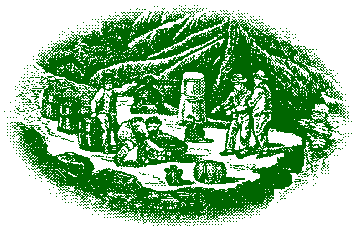 The second requirement youalready meet in full measure, or else you would never have begun,and that is to have a sense of adventure. The history of Scotchwhisky is rife with tales of what has been done (or not done, asthe case may be) to control the taste of whisky. These range fromthe refusal of one distillery owner to remove spider-webs fromthe still-room to the industry practice of carefully dentingreplacement stills to match the mishaps incurred with theoriginals.
The second requirement youalready meet in full measure, or else you would never have begun,and that is to have a sense of adventure. The history of Scotchwhisky is rife with tales of what has been done (or not done, asthe case may be) to control the taste of whisky. These range fromthe refusal of one distillery owner to remove spider-webs fromthe still-room to the industry practice of carefully dentingreplacement stills to match the mishaps incurred with theoriginals.
And no one really doubts that the shape of the still, thedampness and temperature of the warehouse, and the source of thewater all have their effects on the flavour and aroma of thefinished whisky. The problem is: no one really knows therelationships of all these factors to the finished product. Soyou need a sense of adventure because, after you produce yourfirst whisky, you won't know what you have wrought until theyears of ageing have passed.
The third, more practical requirement is a virtuallyinexhaustible source of capital. In these days when long-rangebusiness planning means looking to next year's profits, you haveentered an industry where your first return on investment willcome with sales to blenders after 3 to 5 years - assuming thatyour whisky fills a need in the taste and aroma palettes that theblenders are composing. And, if you want to bring a single maltto market, you will have to wait 8 years or more - assuming thatyour whisky is drinkable in the first place!
Being the patient, adventurous, and wealthy soul that you are,this discussion has only whetted your appetite. So where tobegin?
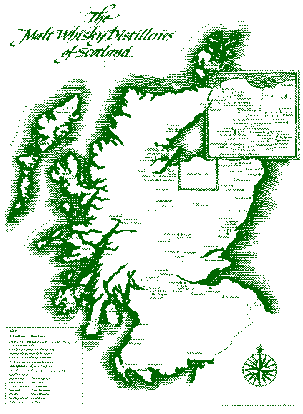
Perhaps the first question is: where should you build yourdistillery? While the differences between malts from theHighlands and from Speyside may be largely a matter of regionaltradition, few would deny that all of the Island malts pick up anelement of sea tang. At the risk of losing a bit of the mystery,we can analyse the source of some differences: location affectsclimate, which in turn affects the temperature and humidity ofthe warehouse. The location also determines the type of waterthat is available. And why should we be surprised if a cask leftfor 30 years next to the sea shore picks up a saltiness not foundin one stored safely in the middle of the Lowlands?
Hence, the site of a distillery is the first and arguably oneof the most important decisions to make. While a distillerysituated between Edinburgh and Glasgow would be in reach ofnumerous amenities, obtaining a whisky with distinctivecharacteristics may be worth the hardships of a more remotelocation. Besides, it's easy to invent romantic stories about adistillery hanging over the edge of a cliff, and rather moredifficult if the distillery is five minutes from High Streetshopping.
Once you know where to put your distillery, you have to decidehow it's going to be built. This is more than simply a matter ofappearance or practicality, particularly where the warehouse isconcerned. Modern metal warehouses with finished floors can getquite hot. This not only speeds up evaporation in general, butcan also cause water to evaporate from the whisky faster thanalcohol. The angels in Scotland are normally partial to alcohol,meaning that the proof strength of whisky tends to decreaseslowly over the years.
This is the main reason that traditional warehouses arethick-walled, earthen-floored constructions. The warehouse stayscool and damp, keeping evaporation slow, which in turn allowsmany years of maturation. The dampness also inhibits theevaporation of water more than that of the alcohol, leading tothe slow reduction in proof strength over the course of time.
The construction of the distillery itself is less critical,and indeed the dedicated distillery visitor sees many styles. Themain concerns are those of cost, efficiency, and, of course, thatextra something necessary to attract visitors and lend extracharacter to the very idea of drinking such a malt. It is notentirely coincidence that many of the best-respected malts comefrom distilleries unusual in some way, and that every distilleryopen to the public seeks to mark itself as the"smallest", "oldest", "highest", orsome other "-est" that will set it apart from themasses.
Once you've built the buildings, it's time for decisions abouthow you will make whisky. You need to select washbacks,stills, and the other apparatus necessary to whisky-making, basedon what you think will produce the best malt, and you need tofind casks to age it in. So let's take a walk through thewhisky-making process.
Whisky begins as barley, water, yeast and peat. A fewdistilleries still grow much of their own barley, or at leastprocure it from local farmers. What is important is that thegrain be of good quality, however this is assured. It takes about2 kg of barley to produce a litre of whisky, so a modestdistillery will need around 2000 tonnes of malted barley peryear.
The barley is malted, meaning it is soaked in water, spread,and allowed to germinate. When barley germinates, it produces anenzyme that converts the starch in the grain into sugar. As soonas germination has produced this enzyme, but before growth hasused up much of the starch, the germination process is halted bydrying.
There are two methods for producing malted barley. The firstis traditional and, as with all things labelled"traditional", is labour intensive. The grain is spreadon the malting floor to germinate. One doesn't quite know how thegrain manages this unaided in the wild, because here you have tohelp it along by regular turning. If you're really traditional,you use a shovel. In distilleries that still have their ownmalting floors, you will find the shovels off in a corner,covered with dust, while the grain is turned by a back-savingmechanical contrivance looking rather like a lawnmower withteeth. Underneath the malting floor is space to build peat fires.Once lit, the heat from these fires dries the grain and stopsgermination, and the peat smoke adds some of the most notabletaste and aroma components to malt whisky. All malt drinkers know(and either love or hate) the Islay distilleries that believethere cannot be too much of a good thing.
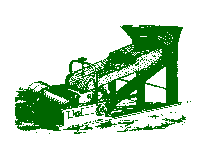 Most distilleries use thesecond method of producing malted barley, namely, let somebodyelse do the hard work. There are a number of central maltinghouses that produce malted barley to order. Although the maltingtakes place away from the distillery, the process is carefullycontrolled and the amount of peat smoke added during drying canbe precisely specified.
Most distilleries use thesecond method of producing malted barley, namely, let somebodyelse do the hard work. There are a number of central maltinghouses that produce malted barley to order. Although the maltingtakes place away from the distillery, the process is carefullycontrolled and the amount of peat smoke added during drying canbe precisely specified.
After drying, the barley is coursely ground into grist.This is the true input to whisky-making, and your 2000 tonnes ofbarley have produced about 1600 tonnes of grist.
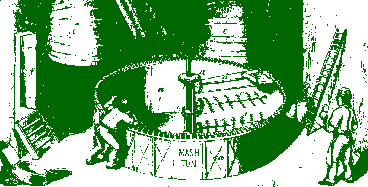 The grist is mixed with hotwater in large metal vessels called mash tuns. The water servesboth to activate the sugar-producing enzyme and to dissolve theresulting sugar (along with many other components). The resultingliquid, wort, is drawn off to be fermented. The solidsremaining behind, about one-quarter of the original, are used ascattle feed.
The grist is mixed with hotwater in large metal vessels called mash tuns. The water servesboth to activate the sugar-producing enzyme and to dissolve theresulting sugar (along with many other components). The resultingliquid, wort, is drawn off to be fermented. The solidsremaining behind, about one-quarter of the original, are used ascattle feed.
The wort is then fermented, producing wash. This isdone in huge wooden vats, called washbacks, which areusually made of Oregon pine and hold anything up to 45000 litres.If you've never seen a washback, try to envision a two-storyhot-tub; and the fermentation process is indeed hot. As itferments, the wash tends to foam, so be generous with the size ofthe washback and don't forget to stir.
The fermentation is caused by a mixture of cultured andbrewers' yeast, which you add by the bagful to the wort, and bybacteria occurring naturally in the atmosphere. These bacteriaare of the same sort that ferment cabbage into sauerkraut, soperhaps you could diversify if the whisky doesn't work out.
Wash has an alcohol content similar to that of ale, which isto say a lot lower than what one expects of a good dram, so thenext step is...
One of your more important decisions is the number of stillsthe whisky-to-be passes through en route to the cask. Lowlandmalts are normally distilled three times, as are traditionalIrish malts. That is, the fermented wash is distilled, theproduct of the distillation distilled again, and the product ofthis second distillation is distilled yet a third time. Thisproduces a characteristically lighter malt, in contrast to thedouble distillation used in most Scottish distilleries. There areexceptions to this, for example, Springbank distills their whisky"two-and-a-half" times; a complicated story bestunderstood over a dram of said whisky.
 The individual still also makes adifference. Although we are speaking here only of malt whiskymade in pot stills, there are nonetheless variations on thetheme. Stills come in various shapes and sizes, though since 1814the minimum has been several hundred gallons. This restrictionwas enacted based on the assumption that it was rather difficultto hie off into the woods with several tons of copper when theexcise man came around. But one can stay at the legal minimum,producing numerous very small batches, or use larger stills andproduce fewer but larger runs of whisky.
The individual still also makes adifference. Although we are speaking here only of malt whiskymade in pot stills, there are nonetheless variations on thetheme. Stills come in various shapes and sizes, though since 1814the minimum has been several hundred gallons. This restrictionwas enacted based on the assumption that it was rather difficultto hie off into the woods with several tons of copper when theexcise man came around. But one can stay at the legal minimum,producing numerous very small batches, or use larger stills andproduce fewer but larger runs of whisky.
This decision is quite important, as the composition of whiskychanges continuously during the distillation. The early part ofthe distillation, called the foreshots, is undrinkable.This is the stuff that makes you go blind, and is understandablynot wanted in malt whisky. The latter part of the run, the feints,contains heavier elements such as fusel oils, and has a noxioustaste. However, fusel oils are important flavour components inmalt whisky, and it is a matter of judgement when they havereached too high a concentration. Between foreshots and feintscomes the middle cut, which will be run into casks forageing as malt whisky. Some distilleries take a very narrow cut,to produce a more consistent whisky, whereas others value theflavour balance that comes from a wider cut of the distillation.
Assuming that you want the usual double-distillation, you willneed one or more wash stills and one or more smaller spiritstills. The exact size and shape undoubtedly have profoundeffects on the whisky they will produce; unfortunately, you won'tfind an analysis in your local library, as no one understandsjust what these effects are. Better to visit your favouritedistilleries, take careful measurements, and drink a few dramsjust as a matter of quality control.
Not to be forgotten is the lyne pipe, which conducts theevaporated liquid away from the still and into the worm. Thesize, shape, and height of the lyne pipe helps determine whichvolatiles make it into the final whisky and which recondense andfall back into the still. So once you have found a good size andshape, you need only find an artistic hammer-wielder to add a fewcarefully placed dents and pings. After all, who are we tocontest legend?
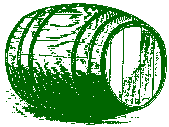 Fresh spirit runs off the still andinto spirit receiver, where it is diluted to 63.5% alcohol. It isthen filled into casks. The casks used to age Scotch whisky mustbe oak and have usually been used previously to store bourbon orsherry. To be called "Scotch", the whisky must maturein the cask for a minimum of three years. When selecting casksfor your whisky, however, it's not merely a matter of buying whatcomes up at the auction block. After all, the death of manyCampbeltown distilleries can be attributed to their erstwhilepropensity for using old fish barrels to store (one daren't say"age") their whisky.
Fresh spirit runs off the still andinto spirit receiver, where it is diluted to 63.5% alcohol. It isthen filled into casks. The casks used to age Scotch whisky mustbe oak and have usually been used previously to store bourbon orsherry. To be called "Scotch", the whisky must maturein the cask for a minimum of three years. When selecting casksfor your whisky, however, it's not merely a matter of buying whatcomes up at the auction block. After all, the death of manyCampbeltown distilleries can be attributed to their erstwhilepropensity for using old fish barrels to store (one daren't say"age") their whisky.
So, do you know where your casks have been? It not only amatter of what they have been used for previously; the history ofa cask is important even farther back. Whisky takes a remarkablenumber of flavour components from the wood, dependent on manyfactors. There are differences between Spanish and American oak,differences between fast-grown and naturally grown oak, and manyother factors that influence the taste and aroma of whisky.
Hence, it is vitally important to know the entire history ofyour cask, and some distilleries not only own rights to forests,but actually employ consultants to select the trees from whichcasks will be made. The casks are then given over to the bourbonor sherry industry for use before being claimed as whisky casks.So, in addition to acquiring the land for your distillery, youmay also want to take the time to buy up some prime oak forest inthe Appalachians.
As a matter of experimentation, some whisky producers arepresently trying various finishes, where a whisky isdecanted into a second cask of a different type for an additionalone or two years of ageing before being bottled. This allows theproducer to add a second set of flavour notes to the whisky, inaddition to what has already been gained from the first cask.Look for some interesting experiments in this area, but don'tpour your single malts down the drain just yet.
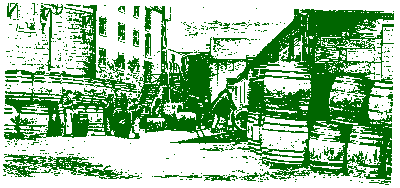 Once your whisky has madeit into the cask, and the cask has been placed in the warehouse,the long sleep begins. But sleep is not inactivity - it ischrysalis. Chemical reactions take place, volatile componentsseep through the cask, flavour components are dissolved from thewood, concentration of all components changes as the angel'sshare evaporates, and many other alterations occur during thepeaceful years of maturation.
Once your whisky has madeit into the cask, and the cask has been placed in the warehouse,the long sleep begins. But sleep is not inactivity - it ischrysalis. Chemical reactions take place, volatile componentsseep through the cask, flavour components are dissolved from thewood, concentration of all components changes as the angel'sshare evaporates, and many other alterations occur during thepeaceful years of maturation.
At this stage it is vitally important to realise that everycask is different. Casks are filled from different distillationruns, each cask is unique and each is stored in a different spotin the warehouse. These various factors lead to differentwhiskies, and it is only by careful selection and combination ofcasks, through the true expertise of the blender, that one canproduce blends and single malts consistent from batch to batch.And a growing group of malt enthusiasts are coming to appreciatethe variations among casks, leading to the increased popularityof single-cask bottlings.
What this means for you, the potential distillery builder, isthat you must periodically sample each cask to see when the maltis mature. Not only do different casks mature whisky at differentrates, but you will also want to produce whisky appropriate tovarious audiences. As with anything, there is a time and placefor every type of whisky. Some occasions demand a lively,exciting young whisky, whereas others are better enhanced by thesomber complexities of an elder malt.
The result is that some casks may be taken early, at 3 or 5years, whereas others may be left to mature longer, sometimesmuch longer. A good quality cask can mature a whisky for 30 yearsor more, producing a marvellously complex malt. However, withevery cask there comes a point where the woody notes start tobecome stronger. If left for too long, this results in a bitterflavour that overwhelms the subtleties of the whisky. Tales of60-year-old whiskies are told by those with strong palates.
Having been through the whisky production process, havinglooked at all of the variables that go into making whisky, andknowing that one must wait years before tasting the first drop ofmature malt, one wonders that anyone in modern times would builda new distillery. Whisky-making is not an easy business, and thisis amply demonstrated by the open-again, closed-again behavior ofmany distilleries.
The singular feature of the whisky-making business is theyears-long delay between production and finished product. Whendeciding what to distill this year, you must predict the demandsof the marketplace years in advance. And you must make the samesort of prediction in deciding which casks to sell and which tolet age farther. Overproduction now may lead to unsellable whiskylater - on the other hand, produce too little and your stocks maysell out too quickly, with no casks left to mature into oldermalts.
New distilleries are occasionally opened, though, mostrecently on Arran. This represents a rare combination of just theright elements. For the rest of us, however, perhaps it is betterto savour the unique products of existing distilleries, and tolet our dreams be dreams.
If you have comments about thissite, please contact the